Sponsored Listings:
Sunbathe in Agadir, learn to surf in Casablanca, trek in the Atlas Mountains, shop in Marrakech’s Medina and see thousands of years of history on the streets of Rabat.
Overwhelmed by the options? Allow us to help you decide where to go.
Best for: Getting to know Morocco
Marrakech
Where is it? In the centre of Morocco – see on map
The souks in Marrakech are full of different sights, sounds and smells.
As well as shopping, there’s also snake charmers, acrobats and dancers entertaining the crowds.
They go to town with the lights at night. You can sit down and eat street food from the chaotic Jemaa el-Fnaa market, in the famous medina quarter. You should also try the fresh-pressed orange juice – there’s loads of vendors to buy some from.
Don’t be shy, barter. The stall owners love it (they’ll probably throw in some tea to sweeten the deal) and you’ll get a bargain – everyone’s happy.
Of course there’s few things that can beat having a drink while the sun sets. You’ll find plenty of roof top bars, like Kechmara, to get those views over the city – glass in hand.
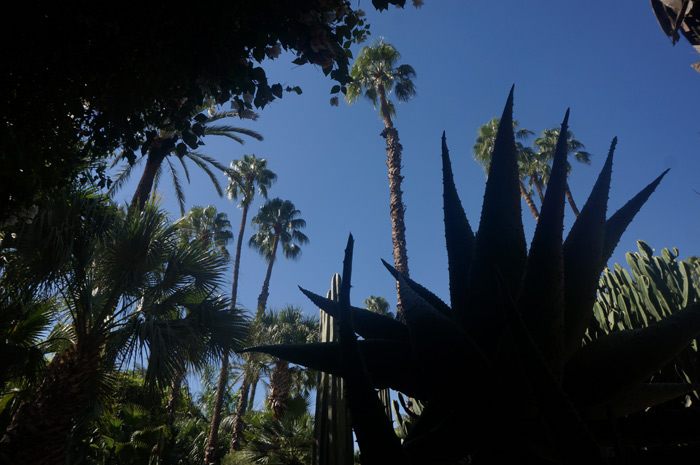
Jardin Majorelle. Image courtesy of Jiving John via Flickr
The Palmeraie (Palm Grove) oasis is just outside the city. You can go on a camel ride or quad bike tour in the desert – and they include a stop off at a traditional Berber home and some refuelling with mint tea.
For a break from the city chaos, the Jardin Majorelle offers some stylish respite in its two and a half acres of cactus, plants and water features – with a bold, blue background.
A blend of Art Deco and Moroccan architecture, the house and gardens were saved by Yves Saint Laurent and Pierre Bergé in the 1980s for the city. It now has a museum and cafe.
Of course the ultimate relaxation is taking a trip to a traditional hammam (spa). You can go super posh at La Mamounia or more local, like the Hammam Dar El Bacha (it’s men in the morning, women in the afternoon).
Best for: Beach holidays
Tangier
Where is it?: The northern tip of Morocco – see on map

View from Hotel Nord Pinus in Tangier
To the west of the ancient port of Tangier isthe Atlantic Ocean. To its east, the Mediterranean Sea.
This is a good place to hit the beach. Cafes and restaurants line the promenade alongside the sand so you can hang out there all day.
More people watching can be done in the Grand Socco (big square) and Petit Socco (little square) in the medina. The former is spacey, arty and cool, its little sister has a more dubious past but has since cleaned up its act.
You can also take a short trip out to the Cave of Hercules. Not only does it have a cool name, but these part-natural, part-man-made caves have a “sea window” which you’ll love if you’re an Instagrammer.
Only rediscovered in the 19th century, it’s gone from a quarry to a brothel, to a UNESCO Heritage Site within 70 years. Pretty good going.
Agadir
Where is it? The south west coast of Morocco – see on map
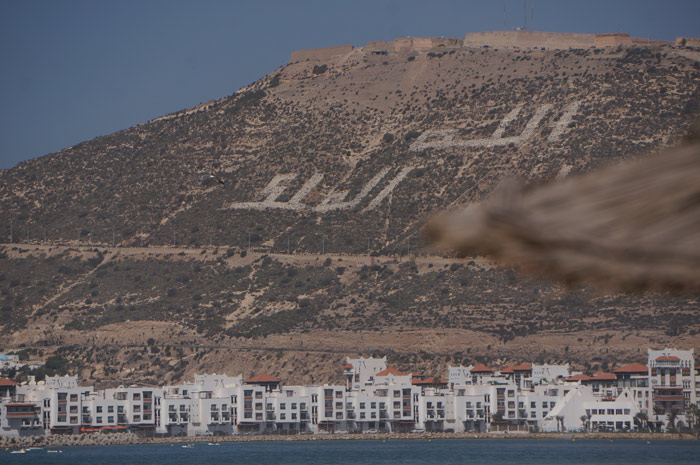
Agadir Beach. Image courtesy of Jiving John via Flickr#
Agadir is one of the country’s most popular holiday destinations. It might be something to do with it having around 300 days of sunshine and a massive beach (it’s six miles long).
This ultra-modern city had to be rebuilt in the 1960s following an earthquake. It’s only a short flight from Marrakech, but getting the train or bus here (three to four hours) means you won’t miss all the desert scenery.
While there’s just a few walls left of the 16th century hilltop Kasbah, the view over the city and port are worth the trip.
If you want see some traditional local Berber villages, there are seven in the Parco Nazionale Souss Massa, just to the south of Agadir. It’s good for bird-spotting too. The bald ibis is its rarest feathered friend, but they also have flamingos.
Best for: Moroccan history and architecture
Fez (or Fes)
Where is it?: The centre of the north, directly south of Tangier and east of Rabat – see on map
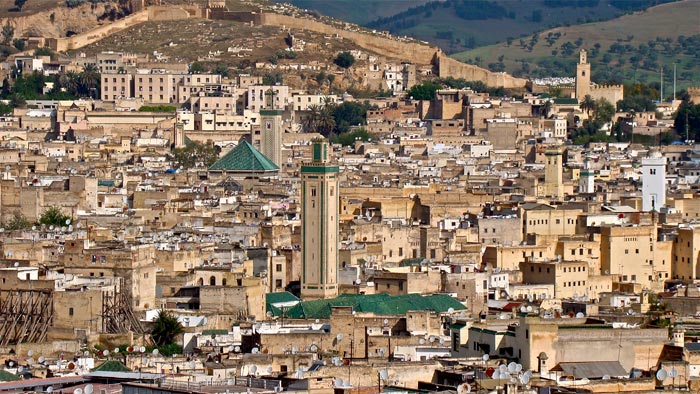
Fez old town
Fez has a large, perfectly preserved, medieval Arabic city centre.
No one’s invented a time machine yet, but Fez does its very best to transport you back to another age.
It’s a former imperial capital – which means it was once the most important city in Morocco (the other three which have swapped places as the capital over the years are Marrakech, Meknes and Rabat).
Seat of learning: You’ll find the oldest university in the world, Kairaouine, in Fez
The Medina of Fez has got high walls flanking the narrow, cobbled streets and is now listed as a World Heritage Site – it’s that good.
The palaces, mosques and fountains in the medina have a mix of Andalousian, Oriental and African architecture.
You’ll find fine examples of madrasas (schools where Islam is taught) like the Medersa el-Attarin and the Bou Inania Madrasa and fondouks – those two story buildings with arches around a central square.
Rabat
Where is it?: Directly west of Fez on the north west coast – see on map
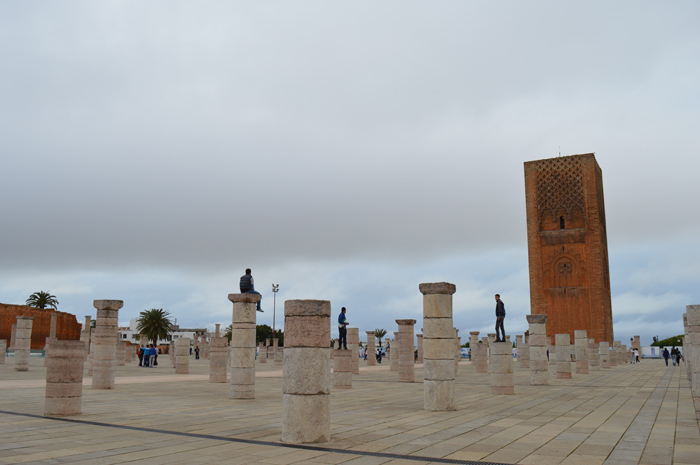
Hassan Tower in Rabat
Morocco’s capital city has changed hands many time over the centuries – and was once ruled by Barbary pirates (corsairs).
It’s World Heritage listed: the 12th century original walled city, the Kasbah of the Udayas, sits alongside a more modern city.
The Hassan Tower is all that’s left of Rabat’s attempt to start building the largest mosque in the world back in the 12th century (see above). The reconstructed columns give you some idea of its intended size.
Of course there’s always the huge sandy beach to visit too – just outside the high walls of the city. Like a lot of the Moroccan coast, there’s a bit of a breeze – but you won’t hear the windsurfers complaining.
Best for: Shopping
Casablanca
Where is it?: On the north west coast south of Rabat – see on map
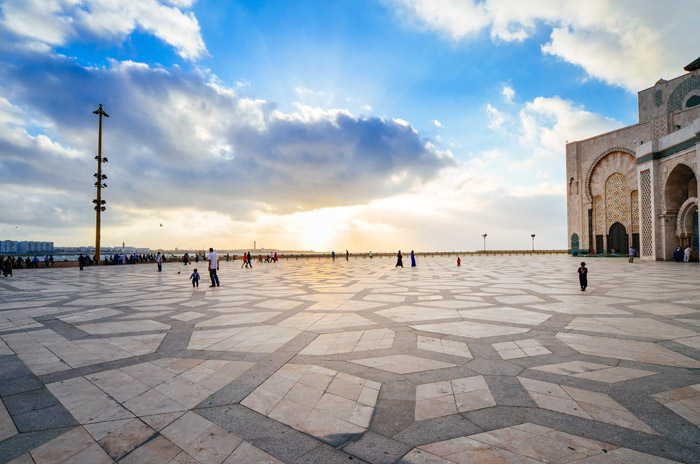
Spoiler alert – Casablanca’s no longer the old port city of the Bogart and Bergman film. But there’s still romance to be found here.
Place Mohammed V is huge (it makes Trafalgar Square look paltry in comparison) and a good place to get your bearings in this big city.
Typical Moorish architecture includes the Mahkama du Pacha. It’s still used as a court, so you can only go inside when it’s not in session.
They’ve got the biggest mosque in Africa here, the Hassan II Mosque, and the tower is the highest in the world so you can’t miss it.
You’ve got a choice here of bartering in the medina’s souks. Or see what the second largest shopping centre in Africa, the Morocco Mall, has to offer – high-end fashion is big here.
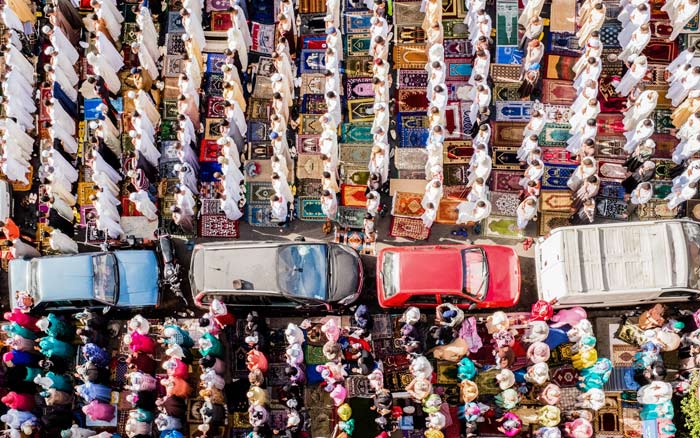
This is another Moroccan city with some cracking beaches, the closest being Ain Diab (it’s not far from the Hassan II Mosque).
The windy weather is beloved of the surfers, and this is a good place to get a lesson. Swimmers might find the seafront pools more appealing for a bit of backstroke.
Best for: Watersports and warm weather
Essaouira
Where is it?: The west coast (west of Marrakech) – see on map

This city has a fantasy fortress feel. So the location scouts for Game of Thrones struck gold when looking for somewhere to feature as a “medieval” desert city.
UNESCO were also impressed with the Medina of Essaouira (formerly called the Lord of the Rings-ish – Mogador), listing the town as a heritage site.
Get up on the ramparts for great views of the Atlantic coastline and then go and see the beach close up.
It’s hot here all-year-round so there will be plenty of opportunities for watersports, swimming and sunbathing.
The Essaouira Gnaoua and World Music Festival is the big event in July. Nearly half a million people attended the jazz, folk, pop and African music extravaganza over the four days in 2016.
Best for : Photo opportunities
Chefchaouen
Where is it?: A couple of hours south east of Tangier in the north of Morocco – see on the map
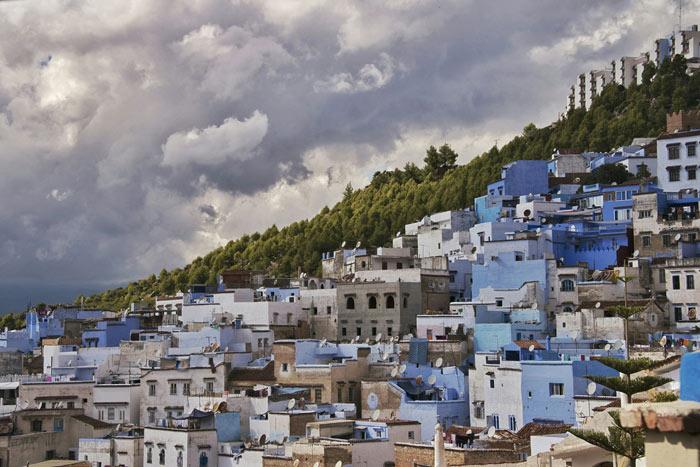
Chefchaouen is known as the blue town. Not because everyone here is depressed, but because most of the Old Town buildings are painted that colour.
And luckily, the colour contrasts really well with the Rif Mountain range behind.
You could do a walking tour through the old medina, or hike out to the Rif Mountains and the Talasemtane National Park. The valleys and gorges are a little greener here than in the Atlas Mountain range.
This is also a good place to pick up a traditional Berber handwoven hat. They’re as colourful as the city.
The town’s got a classic medina to potter around and you’ll probably wind up at its centre at the pretty main square, Plaza Uta el-Hammam. Which is just as well, as this is where the Kasbah and Grand Mosquée can be found.
Mountains and deserts

You can use some of the cities above as a base for seeing more of the mountains and desert regions of Morocco.
As a rule of thumb, you can visit both on a day trip from Marrakech and Agadir.
The biggest summit in the High Atlas range (and indeed north Africa) is Jbel Toubkal.
Agadir’s a cool place to explore the countryside on a motorbike. The roads are excellent and you can travel the coast road before heading into the Atlas Mountains.
Morocco also has some of the tallest sand dunes in the world. The village of Merzouga has loads of companies just waiting to whisk you off on a desert trek and visit the dunes of Erg Chebbi.
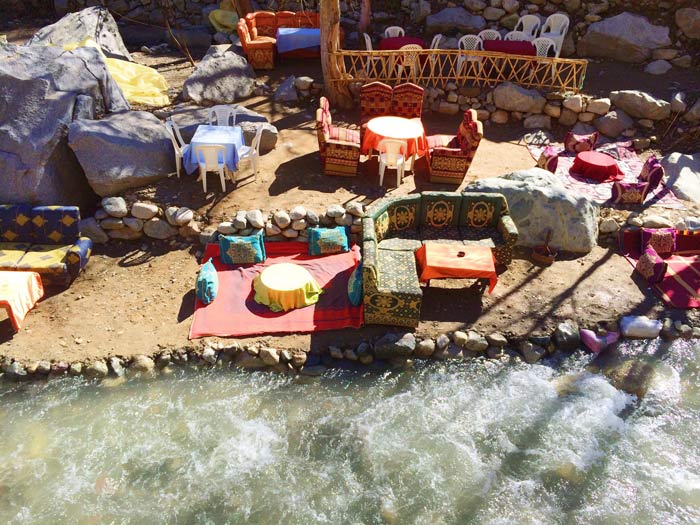
Riverside restaurants in the Atlas Mountain’s
Here’s your essential Morocco information
Currency:
You’ll be using the Moroccan Dirham – find the latest exchange rate. There’s plenty of cash machines in the major cities if you don’t want to bring too much cash over with you.
Language:
Moroccan Arabic (the official tongue) and French are the two main languages here. You’ll be able to get by in English, especially in the cities and tourist areas. There’s also a lot of Spanish speakers here as it’s pretty close to the southern tip of Spain.
Food and drink:
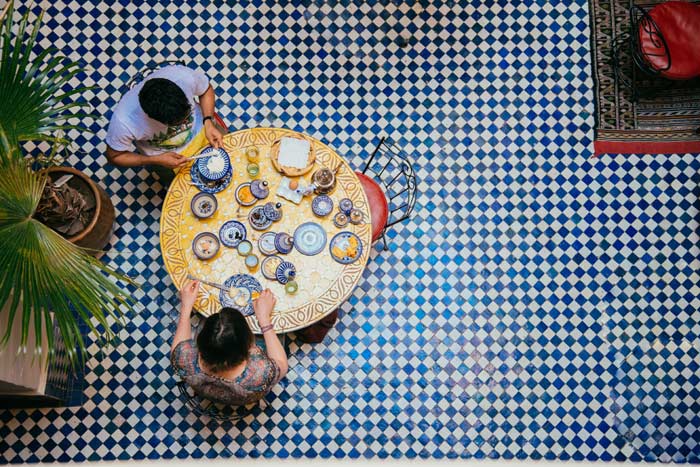
The cuisine here is a blend of Arabic, Berber (North African), French and Spanish flavours and spices.
Tuck into steaming tagines of meat or vegetables, mopped up with Moroccan-style bread or couscous. It’s a hot country so the salads are good too.
You can drink alcohol in the majority of hotels and licensed bars. You’re not going to get a beer out in the souks and street food markets – and it’s illegal to drink in the street.
They do however have the freshest orange juice on sale in the souks and streets. And of course there’s the mint tea which is as much about a tradition of hospitality than just a drink.
When to go:
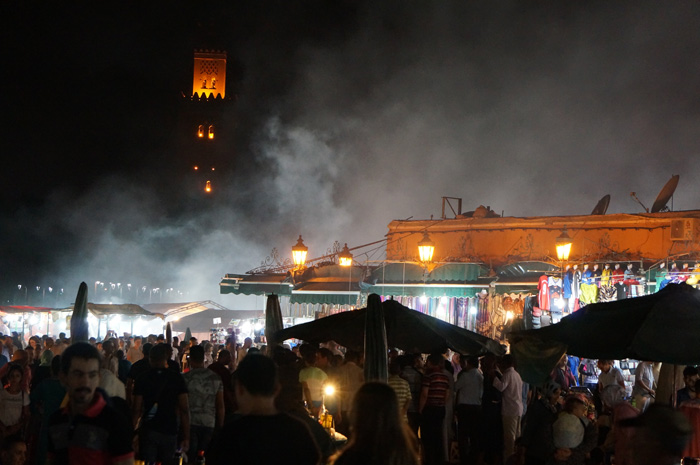
Jemaa el Fna Square at night. Image courtesy of Jiving John via Flickr
Good news, the weather’s decent all-year-round.
We’ve picked both Marrakech and Essaouira as two of our best winter sun destinations.
Spring and autumn are also very popular times (and therefore a touch more expensive). You get lovely warm weather and avoid the sometimes stifling heat of the peak summer with average temperatures in the late twenties.
You might want to check when Ramadan takes place before you visit. As you need to be sensitive in your eating and drinking during the day, and in the clothes you wear.
It can mean some restaurants and cafes are closed during daylight, however in the main tourist places you should be fine.
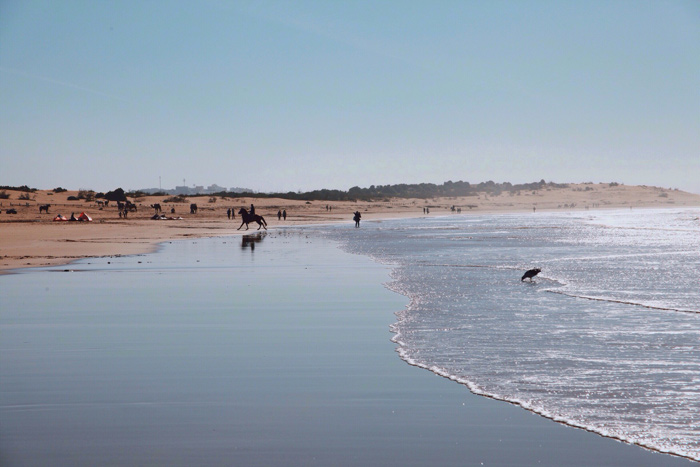
Casablanca’s beach
Getting there:
Flights to Morocco take between three to four hours.
Marrakech flights take around three and a half hours, while if you’re going to Tangier, it’s less than three hours.
Staying there:
We’ve got plenty of Morocco hotels to choose from when you visit. You can also combine your hotel and flight in one with our Morocco holidays – this can be a cheaper option for longer stays.
Find out more about our deals to Morocco.
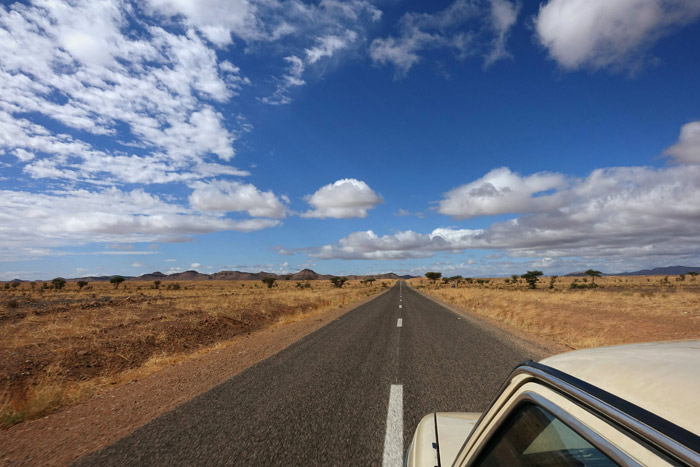
Amerzgane
Care to share your Moroccan memories?
We’d love to know where you think the best places to go in Morocco are.
Tell us your top travel tips by leaving a comment below.
The post Sand, Souks And Spas: Where To Go In Morocco appeared first on lastminute.com Blog.
Source: lastminute.com










